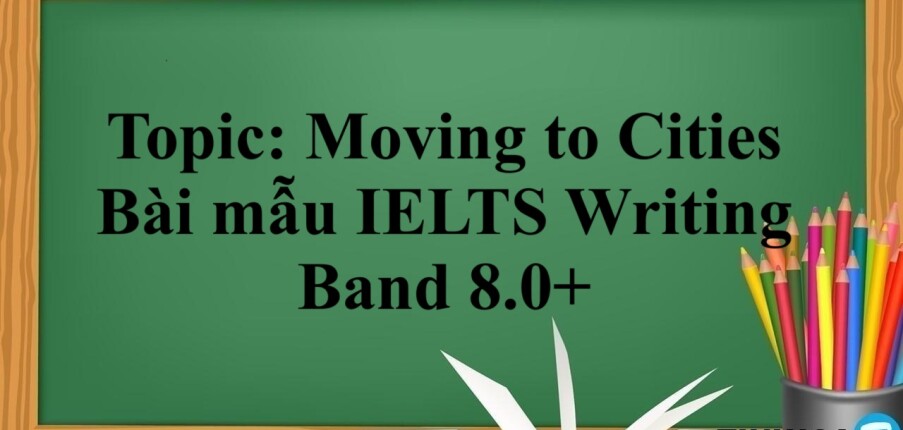Topic: Moving to Cities | Bài mẫu IELTS Writing Band 8.0+
Phân tích
1. Phân tích đề bài
Đề bài:
In many countries around the world, rural people are moving to cities, so the population in the countryside is decreasing. Do you think this is a positive or negative development?
Ở nhiều nước trên thế giới, người dân nông thôn đang chuyển đến các thành phố, vì vậy dân số ở nông thôn ngày càng giảm. Bạn có nghĩ rằng đây là một sự phát triển tích cực hay tiêu cực?
=> Đề bài thuộc dạng Agree or Disagree.
2. Dàn ý
Introduction:
- Paraphrase đề bài: Trong những năm gần đây, dân số nông thôn ở nhiều quốc gia trên toàn thế giới đã giảm khi nhiều cư dân di cư đến các thành phố.
=> In recent years, rural populations in many countries worldwide have been declining as more residents migrate to cities.
- Nêu ý kiến cá nhân: Theo tôi, điều này có thể được coi là một sự phát triển tiêu cực.
=> In my opinion, this can be viewed as a negative development.
Body 1: Biện chứng số một:
- Một trong những mối quan tâm chính liên quan đến di cư từ nông thôn ra thành thị là sự căng thẳng mà nó gây ra đối với cơ sở hạ tầng và tài nguyên đô thị.
=> One of the primary concerns associated with rural-to-urban migration is the strain it places on urban infrastructure and resources.
- Ví dụ: Khi nhiều người đổ xô đến các thành phố => nhu cầu về nhà ở, giao thông, y tế và giáo dục tăng cao => quá tải và gia tăng áp lực lên các cơ sở hiện có => cơ sở hạ tầng không phù hợp, dịch vụ công quá tải và chất lượng cuộc sống của người dân đô thị giảm sút.
=> As more people flock to cities => a surge in demand for housing, transportation, healthcare, and education => overcrowding and increased pressure on existing facilities => inadequate infrastructure, overwhelmed public services, and a decline in the quality of life for urban dwellers.
Body 2: Biện chứng số hai:
- di cư ồ ạt khỏi các vùng nông thôn gây hại cho đất nông nghiệp => ảnh hưởng đến sản xuất lương thực và kinh tế nông thôn.
=> the mass exodus from rural areas harms agricultural lands => impacting food production and rural economies.
- Ví dụ: ở các vùng nông thôn phụ thuộc nhiều vào nông nghiệp, chẳng hạn như các cộng đồng nông nghiệp, việc di cư của người dân đến các thành phố dẫn đến tình trạng mất lao động có kỹ năng trong lĩnh vực nông nghiệp.
=> in rural regions heavily dependent on agriculture, such as farming communities, the migration of people to cities results in a loss of skilled labor in the agricultural sector.
Conclusion:
=> In conclusion, the decline in the countryside population due to rural-to-urban migration has numerous negative implications.
Bài mẫu band 6.5+
The migration of rural populations to urban areas is a global trend that has led to noticeable population declines in the countryside. While urbanization brings certain benefits, I believe that the displacement of the rural population poses both advantages and significant challenges, making this phenomenon a development with mixed impacts.
On one hand, rural-to-urban migration opens up a wealth of opportunities for individuals, enhancing both personal and economic growth. Cities offer a variety of jobs, often in specialized fields like technology and finance, providing people with access to higher wages and better career prospects. Additionally, cities typically have advanced infrastructure, including superior healthcare, education, and public services, which can drastically improve quality of life. By moving to cities, individuals not only improve their personal circumstances but also contribute to urban economic growth, fostering innovation and sustaining market demands.
However, the negative consequences of rural depopulation are far-reaching. The movement of younger generations away from rural areas leaves these regions with labor shortages, undermining agricultural productivity and weakening local economies. As a result, rural communities struggle to maintain essential services, which in turn widens the economic and social divide between rural and urban areas. Urban centers, meanwhile, face increased strain on infrastructure due to rapid population growth. Issues such as overcrowding, higher housing costs, and stretched healthcare services can diminish the quality of life for all residents, new and established alike.
In conclusion, although urban migration offers individuals opportunities for advancement, the long-term impacts on rural areas and urban infrastructure present serious concerns. Consequently, this trend is both a positive and negative development, depending on the perspective.
Bài mẫu band 7.0+
Nowadays, there is a trend of migrating to urban areas from rural areas which is actually an alarming situation as it is the reason for the falling population in those rural areas. In my opinion, this trend causes several negative impacts on the country and the essay will depict those points.
It can not be denied that there are some advantages of moving to cities from rural areas of a country. First of all, city life offers more facilities to its population. For example, cities are far ahead of the villages in case of better education, lifestyle and communication. While it is obvious that the city dwellers can easily access those advantages which the village people find very difficult to get, cities are also superior to the rural areas in case of better transportation system.
But, on the other hand, leaving rural areas for good is not recommended at all. To support this statement, I think that village areas are the powerhouses of a country. Most of the basic goods are produced in those areas which can not be produced in cities. Moreover, if the economy of a country is dependent on the agricultural sector, the odds favour the villagers as they are the producers of the most valuable products which are agricultural goods. To cite an example, most of the agricultural countries depend on their countryside for the development of their agriculture. So, if the population of villages declines day by day, there will be a crisis of workforce which will bring an enormous negative impact on the overall production which will hamper the growth of production.
Another point is that, migrating to cities causes increased population density which ultimately lowers the quality of lifestyles and the city people suffer from lots of drawbacks.
In conclusion, In my opinion, the negative impacts of migration from the rural areas to the cities outweigh the positive sides. So, the policymakers should take necessary steps to develop the rural areas in order to stop people from moving to the urban areas.
Bài mẫu Band 8.0+
In many countries around the world, rural people are moving to cities, so the population in the countryside is decreasing. Do you think this is a positive or negative development?
In recent years, rural populations in many countries worldwide have been declining as more residents migrate to cities. In my opinion, this can be viewed as a negative development with various repercussions for both rural and urban communities.
One of the primary concerns associated with rural-to-urban migration is the strain it places on urban infrastructure and resources. As more people flock to cities, there is a surge in demand for housing, transportation, healthcare, and education, leading to overcrowding and increased pressure on existing facilities. This can result in inadequate infrastructure, overwhelmed public services, and a decline in the quality of life for urban dwellers. This can be seen in the increased demand for housing, where urban areas struggle to accommodate the influx of people. In many cities, the housing market becomes highly competitive, leading to soaring rental prices and a lack of affordable housing options. This puts pressure on low-income individuals and families, who may struggle to find suitable accommodation.
Furthermore, the mass exodus from rural areas harms agricultural lands, impacting food production and rural economies. With a declining rural population, there is a reduced agricultural workforce, impacting food production and supply. For example, in rural regions heavily dependent on agriculture, such as farming communities, the migration of people to cities results in a loss of skilled labor in the agricultural sector. As younger generations leave rural areas, the knowledge and expertise passed down from previous generations diminish, affecting farming practices and productivity. The dwindling workforce can struggle to keep up with the demands of cultivating and harvesting crops, potentially leading to decreased agricultural output and food scarcity.
In conclusion, the decline in the countryside population due to rural-to-urban migration has numerous negative implications. Principally, overcrowding in cities and food supply problems.
- repercussion (n): hậu quả
- urban (adj): (thuộc về) thành thị
- strain (n): sự căng thẳng
- infrastructure (n): cơ sở hạ tầng
- resource (n): tài nguyên
- surge (n): sự dâng trào, gia tăng mạnh
- healthcare (n): sự chăm sóc sức khỏe
- overcrowding (n): sự đông đúc, chật chội
- facility (n): tiện nghi, tiện ích
- quality of life (n): chất lượng cuộc sống
- urban dweller (collocation): cư dân đô thị
- accommodate (v): chứa đựng, cung cấp chỗ ở
- influx (n): dòng chảy
- soaring (adj): tăng vọt
- low-income (adj): thu nhập thấp
- exodus (n): cuộc di cư
- workforce (n): lực lượng lao động
- expertise (n): kiến thức chuyên môn
- diminish (v): giảm bớt
- productivity (n): năng suất
- dwindling (adj): giảm dần dần
- output (n): đầu ra, sản lượng
- scarcity (n): sự khan hiếm
Bài dịch:
Trong những năm gần đây, dân số nông thôn ở nhiều quốc gia trên toàn thế giới đã giảm khi nhiều cư dân di cư đến các thành phố. Theo tôi, đây có thể được coi là một sự phát triển tiêu cực với nhiều tác động khác nhau đối với cả cộng đồng nông thôn và thành thị.
Một trong những mối quan tâm chính liên quan đến di cư từ nông thôn ra thành thị là sự căng thẳng mà nó gây ra đối với cơ sở hạ tầng và tài nguyên đô thị. Khi nhiều người đổ xô đến các thành phố, nhu cầu về nhà ở, giao thông, chăm sóc sức khỏe và giáo dục tăng cao, dẫn đến tình trạng quá tải và gia tăng áp lực đối với các cơ sở hiện có. Điều này có thể dẫn đến tình trạng thiếu cơ sở hạ tầng, quá tải các dịch vụ công cộng và suy giảm chất lượng cuộc sống của cư dân đô thị. Điều này có thể được nhìn thấy trong nhu cầu gia tăng về nhà ở, nơi các khu vực đô thị phải vật lộn để đáp ứng dòng người. Ở nhiều thành phố, thị trường nhà ở trở nên cạnh tranh cao, dẫn đến giá thuê tăng vọt và thiếu các lựa chọn nhà ở giá rẻ. Điều này gây áp lực lên các cá nhân và gia đình có thu nhập thấp, những người có thể gặp khó khăn trong việc tìm chỗ ở phù hợp.
Hơn nữa, cuộc di cư hàng loạt từ các vùng nông thôn gây hại cho đất nông nghiệp, ảnh hưởng đến sản xuất lương thực và kinh tế nông thôn. Với dân số nông thôn giảm, lực lượng lao động nông nghiệp giảm, ảnh hưởng đến sản xuất và cung ứng lương thực. Ví dụ, ở các vùng nông thôn phụ thuộc nhiều vào nông nghiệp, chẳng hạn như các cộng đồng nông dân, việc di cư của người dân đến các thành phố dẫn đến tình trạng mất lao động có kỹ năng trong lĩnh vực nông nghiệp. Khi các thế hệ trẻ rời khỏi vùng nông thôn, kiến thức và chuyên môn được truyền lại từ các thế hệ trước giảm đi, ảnh hưởng đến các phương thức canh tác và năng suất. Lực lượng lao động đang suy giảm có thể phải vật lộn để theo kịp nhu cầu trồng trọt và thu hoạch mùa màng, có khả năng dẫn đến giảm sản lượng nông nghiệp và khan hiếm lương thực.
Tóm lại, sự suy giảm dân số nông thôn do di cư từ nông thôn ra thành thị có nhiều tác động tiêu cực. Về cơ bản, tình trạng quá tải ở các thành phố và vấn đề cung cấp thực phẩm.
Lời kết
Hy vọng rằng bài giải mẫu của 1900 cho đề thi IELTS Writing Task 2 thuộc Topic Moving to Cities đã cho các bạn cách làm bài sao cho đạt được band điểm mong ước.
Nếu có thắc mắc, hãy để lại bình luận và 1900 sẽ giải đáp nhé!
Xem thêm các tài liệu Tiếng Anh hay, chi tiết khác:
TOP Việc làm "HOT" dành cho sinh viên:



